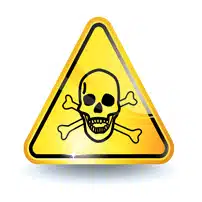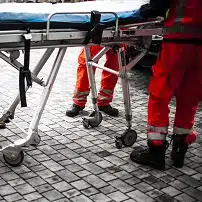A construction site is an inherently dangerous place. Heavy machinery and equipment, power tools, working at heights, and unfinished electrical work are just some of the occupational hazards that construction workers are exposed to on a daily basis. However, one safety hazard that is often overlooked is the risk of injury from toxic chemicals. Hazardous chemicals cause more than 190,000 illnesses and 50,000 fatalities every year in the United States, according to the Occupational Safety and Health Administration (OSHA). Unfortunately, construction workers may not even realize they have been exposed to a dangerous chemical until they develop a health condition or injury related to toxic exposure, such as:
- Respiratory conditions.
- Skin disease.
- Cancer.
- Lung disease.
- Neurological injuries.
- Reproductive damage.
- Endocrine disruption.
Exposure to toxic chemicals can cause both minor conditions, such as skin allergies and long-term serious injuries, including damage to the lungs and other internal organs. In the worst cases, exposure can lead to life-threatening illnesses like cancer.
What Are Some of the Chemicals Used in Construction?
Chemicals are everywhere in the materials used for construction, and their use is strictly regulated by OSHA. Some of the most dangerous and prevalent types of chemicals found on construction sites include the following:
- Lead: Used in plumbing fixtures and for soldering.
- Mercury: Contained in compact fluorescent lighting (CFL) fixtures, electrical devices, batteries for cordless power equipment, and commercial and residential thermostats.
- Halogenated flame retardant chemicals: Used as insulation between walls and around wiring.
- Polyvinyl chloride: Commonly used to coat pipes and insulate electrical wiring as well as for flooring, taping compounds, ductwork, sheet roofing, shingles, and block insulation.
- Cadmium: Found in steel products with rust protection coatings.
- Silica: Contained in concrete, stone, bricks, tiles, and sand.
- Asbestos: Used in many insulating materials before the Environmental Protection Agency (EPA) banned most asbestos products.
- Zinc: Use of galvanized steel in construction is common, and the protective coating is made from zinc. Cutting and welding zinc-based materials or zinc coated materials can expose workers to toxic fumes.
- Formaldehyde: A preservative used to treat the wood for construction.
How Do Chemical Injuries Occur in the Construction Industry?
Chemical exposure on construction sites can happen in different ways. Dangerous chemicals can be present in solid, liquid, or gas form, such as dust, fibers, mists, and fumes. They can travel through the air and be breathed in, swallowed, or absorbed through the skin. Some chemicals release toxins as they break down. Others become even more threatening when they come into contact with heat and fire.
New construction may require the handling, cutting, or welding of materials containing hazardous chemicals. Demolition of older buildings can release high volumes of toxic smoke and gases when they are deconstructed, including substances that have deemed too dangerous for further use.
Workers can be injured by chemicals through exposure to materials that they use every day, such as industrial solvents, primers, and soldering agents. However, construction accidents involving chemicals can also seriously harm workers.
Preventing Chemical Injuries in the Construction Industry
OSHA has mandatory procedures to clearly identify and safely store hazardous chemicals and requires that employers train workers on how to safely handle them. Additionally, employers must provide safety equipment to workers at risk for toxic chemical exposure, including eye protection, air filtration, and gloves.
Proper ventilation is essential for protecting workers from the unseen threat of exposure to and absorption of chemicals being used in construction. Emergency escape routes must be planned and posted so that workers know what to do in the event of a fire or the release of toxic chemicals.
Training must be given in a language that the worker can understand to ensure they fully comprehend the health risks associated with the chemicals in their environment. They should know how to use the personal protective equipment (PPE) associated with each task.
Workers’ Compensation for Construction Workers
Construction workers who are injured on the job are eligible for Workers’ Compensation benefits, however, those with serious and life-threatening injuries or illnesses may need more than what their benefits provide. Depending on the circumstances, there may be more legal options available for compensation. While the Workers’ Compensation system prevents employers from being sued for workplace chemical injuries, if another party’s negligence contributed to the toxic chemical exposure, they could be held liable. Examples of third-party liability include:
- A chemical manufacturer or distributor who failed to disclose and warn of the safety hazards associated with their product and the types of PPE needed.
- A property owner of the construction site where the toxic chemical exposure happened failed to follow OSHA regulations and safety guidelines.
- A subcontractor who failed to follow OSHA regulations and safety guidelines for working with toxic chemicals.
- A manufacturer or distributor who failed to properly warn of the dangers to workers operating the machinery.
- A manufacturer of PPE that was faulty and failed to keep workers safe from exposure to toxic chemicals.
- A storage company who failed to properly store the toxic chemicals.
A successful third-party claim can recover compensation for the types of non-economic damages not included under Workers’ Compensation, such as pain and suffering, emotional distress, and diminished quality of life. Consult with an experienced lawyer to determine if you are eligible to file a claim for benefits.
Wilmington Construction Accident Lawyers at Rhoades & Morrow Advocate for Construction Workers Suffering From Chemical Injuries
If you are a construction worker who suffered chemical injuries on the job, our Wilmington construction accident lawyers at Rhoades & Morrow can help. Our experienced team can answer all of your questions. To schedule a free case evaluation today, call us at (302) 427-9500 or contact us online. We have offices in Wilmington, Bear, Milford, and Lewes, Delaware. With offices in all three counties of Delaware, we serve clients throughout the state.





